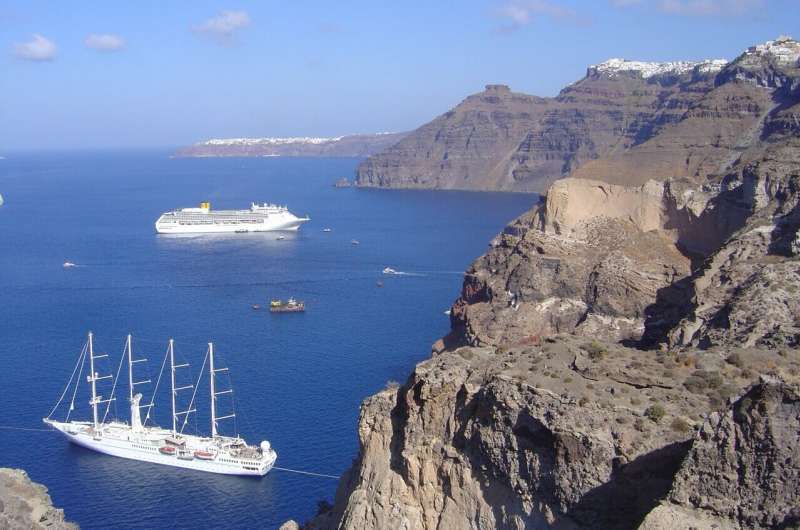Sea levels influence eruptions on volcanic island

The rise and fall of sea levels influence the likelihood of volcanic eruptions on the Greek island of Santorini, new research led by Oxford Brookes University has discovered. Analyzing the timings of eruptions over hundreds of thousands of years, the researchers found that a 40 meter fall in sea level is a crucial point beyond which eruptions are more likely to occur. The findings could have implications for millions of people living on volcanic islands around the world.
Santorini—cliffs reveal history of eruptions
The research on the popular tourist destination was led by Dr. Christopher Satow, Senior Lecturer in Physical Geography at Oxford Brookes.
He says there are clues about past volcanic activity on Santorini in the layers of rock on the cliff face encircling the inner part of the island: "A huge eruption 3,600 years ago caused the center of what was then a conical island to sink into the sea, revealing an extraordinarily detailed history of over 200 volcanic eruptions preserved within the remaining circle of cliffs.
"Comparing this eruption history to a sea level record allowed us to show for the first time that the sea level has had an important role in determining the timing of eruptions at Santorini, and probably at many other island volcanoes around the world.
"The mechanism is quite simple: falling sea levels remove mass from the Earth's crust and the crust fractures as a result. These fractures allow magma to rise and feed eruptions at the surface."
The researchers say that eruptions at hundreds of other volcanic islands around the world may also have been influenced by fluctuations in sea level. Dr. Satow added: "Just as when you pull a plug out of the bath, the water level drops everywhere throughout the bath at the same time; in a similar way, sea level changes occur at the same time everywhere across the globe."
Volcanic eruptions and climate change
Volcanic eruptions can change the climate, for example the eruption of the Philippines' Mt. Pinatubo in 1992 resulted in a fall in global temperature of 0.5 C.
But Dr. Satow says the climate also impacts on volcanic activity: "What is less well known is that on long timescales, the climate can also affect volcanoes. As ice sheets retreated across volcanic landscapes after the last ice age, the removal of mass changed the stress conditions in the Earth's crust, allowing the fractures which feed volcanic eruptions to form more easily.
"As these ice sheets melted the global sea level rose rapidly, by around 100 meters, adding a significant mass to the crust around many volcanic islands which, in theory, should alter their eruptive activity."
Dr. Satow concludes: "57% of the world's volcanoes are islands or are coastal, and are often home to large populations. Further vital research is needed to fully understand the effects of changing sea level on these volcanoes and the risks they pose to their populations."
Dr. Satow collaborated with researchers from Royal Holloway University of London, Keele University, the University of Oxford, Uppsala University in Sweden, the University of Portsmouth and the University of Leicester.
"Eruptive Activity of Santorini Volcano Controlled by Sea Level Rise and Fall" is published in Nature Geoscience.
More information: Eruptive activity of the Santorini Volcano controlled by sea-level rise and fall, Nature Geoscience (2021). DOI: 10.1038/s41561-021-00783-4 , www.nature.com/articles/s41561-021-00783-4
Journal information: Nature Geoscience
Provided by Oxford Brookes University




















